
![]()
![]()
The Royal Ploughing Ceremony was probably, in the old times, the rite designed to remind the farmers and to give an auspicious beginning to the new planting season especially the rice farming that is the major source of food. The leader or the rulers of the country preside over the ceremony when the planting seasons begin. to remind the farmers and to give an auspicious beginning to the new planting season especially the rice farming that is the major source of food. The leader or the rulers of the country preside over the ceremony when the planting seasons begin.
After some times passed, the Brahmanic rite called Ploughing ceremony was then introduced. Its purpose is to encourage the power and happiness. Bhraman were instructors for the ceremony. The king or the leader of the country may designate this duty to a respective high-ranking officer to perform the ceremony as Phraya Raekna, Lord of the Ploughing Ceremony. The roles of the queen or wives who had to help ploughing are designated to four celestial maidens, called the queen of sowing ceremony, assisting Phraya Raekna by carrying seeds containers and distribute the seeds after Phraya Raekna had ploughed the ground. The Royal Ploughing Ceremony has been annually performed for thousands of years in several countries such as China and India.
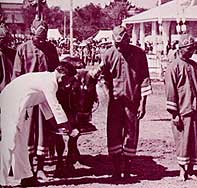 In Thailand, this ceremony has been performed since Sukhothai was the capital. It had been continued in Ayuthaya and Ratanakhosindhu (Bangkok) period. The Royal Ploughing ceremony performed during the reign of King Rama I, II, and III was purely the Bhramanic rite as it had been in Ayutthaya period i.e. there was no Buddhist monk participated in the ceremony.
In Thailand, this ceremony has been performed since Sukhothai was the capital. It had been continued in Ayuthaya and Ratanakhosindhu (Bangkok) period. The Royal Ploughing ceremony performed during the reign of King Rama I, II, and III was purely the Bhramanic rite as it had been in Ayutthaya period i.e. there was no Buddhist monk participated in the ceremony.
In the reign of King Rama IV, the King had royal command to initiate the Buddhist rite together with the original ceremony. The reason was to prosper all the cereals brought into the ceremonial field. After the Buddhist rite that is performed in the first day, the Bhramanic ceremony The combined rite was so called the Royal Ploughing ceremony that lasts for 2 days.
The Royal Ploughing Ceremony is very important and it is a prosperous ceremony to encourage all the farmers.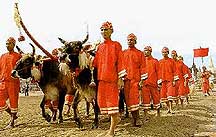
?The ancestral masters had set the rule that the ceremony must be performed on the best day of the year, comprising the auspicious occasions as stated in the treatise of astrology. This particular day must also be in the sixth month and the traditional auspiciousness is based on the lunar calendar
The day for Royal Ploghing Ceremony therefore cannot be set in a certain date. However, it is normally in May. The reason that it is required to be in the sixth month is that it is the beginning of raining season. This time is a good time for farmers to start working on their farm, which is an important work of Thai society for a very long time.
After the royal astrologer had already calculated and got the auspicious day for the Royal Ploughing Ceremony, The Bureau of the Royal Households would mark the calculated date into the royal calendar that the king annually gives to his people. The calendar clearly states the date for both rites of the ceremony. The Royal Ploughing ceremony day is announced by the cabinet as a Public holiday but the national flag is raised as it is in usual working days.
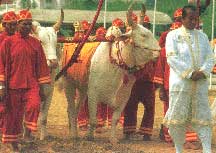
The Royal Ploughing Ceremony had been taken place until 2479 B.E. before it had been skipped until 2483 B.E., the year that the government re-announced only the Buddhist rite for cereals was to be taken place at the church in the temple of the Emmerald Buddha.
The Buddhist rite for cereals had been the royal ceremony to encourage auspicious cereals before they were brought to the Royal Ploughing Ceremony. It was conducted a day prior to the ploughing day. The importance of the beginning of the ploughing ceremony was announced on that day
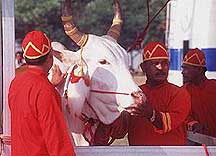
The announcement referred the Buddhist Dharma (the teaching of Buddha) that mentioned the drought was eliminated by the Buddha's power, which caused raining enabling farmers to normally work on their farm. It also mentioned the construction of khanthanraj at the city of khanthanraj. This project was related to the Buddha's power that caused raining. There was then an announcement to honor King Rama I who initiated the construction of Buddha khanthanraj for the Royal Ploughing Ceremony, as this royal ceremony had been conducted by the kings since the old times. The last part was the announcement of wishes for the king altogether with the wish to ask all holy spirits to bless and to protect plants in the kingdom healthily grown with rich of seasonal rainwater. After the announcement, 11 Buddhist monks recite a special chant for the auspicious cereal rite. This chant covers all kind of cereals brought into the ceremonial field. The cereals include rice grains, beans, corns, sesame, pumpkins, melons, taros, and cottons.
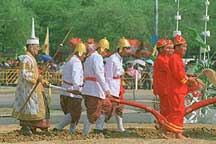 In 2503 B.E., the general secretary of the Royal Palace received a royal command regarding the Royal Ploughing Ceremony. The two parts of the ceremony originally had been taken place in two separated days. Later, the ploughing part was skipped. In 2503, the government had decided to reestablish the ploughing part in order to conserve this great traditional royal ceremony for agriculture. The Bureau of the Royal Households and the ministry of agriculture reset this traditional royal ceremony and it has been intact since 2503 B.E. until present. The King Rama IX has been presiding over this royal ceremony every year. He also gave royal wish to the ceremony committee to organize the ceremony contemporary.
In 2503 B.E., the general secretary of the Royal Palace received a royal command regarding the Royal Ploughing Ceremony. The two parts of the ceremony originally had been taken place in two separated days. Later, the ploughing part was skipped. In 2503, the government had decided to reestablish the ploughing part in order to conserve this great traditional royal ceremony for agriculture. The Bureau of the Royal Households and the ministry of agriculture reset this traditional royal ceremony and it has been intact since 2503 B.E. until present. The King Rama IX has been presiding over this royal ceremony every year. He also gave royal wish to the ceremony committee to organize the ceremony contemporary.
The Royal Ploughing ceremony was originally conducted at Phaya Thai rice field. But when the ceremony was reestablished in 2503 B.E., it was then moved to the Sanam Luang Ground that used to be a ceremonial ground in the reign of King Rama I, II, and III. The Phraya Raekna was the minister of agriculture. The four celestial maidens were ladies who work in the royal palace.
Since there were changes, the new duty of Phraya Raekna was then assigned to the director general of rice department, the ministry of agriculture. The four celestial maidens were selected from female officials who worked in the ministry of agriculture.
In the consecutive years until present, the Phraya Raekna duty has been assigned to a permanent undersecretary of the ministry of agriculture and cooperatives. The celestial maidens are selected from single female officials, ranked 3rd-4th levels, who work in the ministry of agriculture.
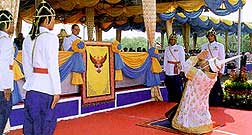 The Royal Ploughing Ceremony is the ceremonial event that brings auspiciousness to cereals and also encourages farmers to carry out farming works. His Majesty the King has been interested in this ceremony. He has been to the ceremony every year to preside this traditional royal ceremony and to make a wish for prosperity of Thai agriculture.
His Majesty the King has conducted the experiment in planting rice in his personal rice field in Chitrlada Villa, Dusit Palace, where he lives. After the harvesting, he kindly gave 40-50 kilograms of rice grains for the ceremony.
The Royal Ploughing Ceremony is the ceremonial event that brings auspiciousness to cereals and also encourages farmers to carry out farming works. His Majesty the King has been interested in this ceremony. He has been to the ceremony every year to preside this traditional royal ceremony and to make a wish for prosperity of Thai agriculture.
His Majesty the King has conducted the experiment in planting rice in his personal rice field in Chitrlada Villa, Dusit Palace, where he lives. After the harvesting, he kindly gave 40-50 kilograms of rice grains for the ceremony.
The King's rice grains were separated into two portions. The first portion is distributed into the ceremonial ground. The second portion was contained in small packs and sent to provinces of Thailand. Those packs are later distributed to farmers for their auspicious believes and follows the King's wish to encourage and support the agriculture.
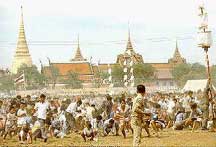
Reference
"The Royal Ploghing Ceremony day" Pikul-Chan. 22 (14-20 May 2544 B.E.) p 4-5
Pictures from
1. http://kanchanapisek.or.th
2. http://www.stjohn.ac.th/University/Cultural/salath_aplmay4.html
3. http://asiarecipe.com/thaiplou.html
4. http://www.geocities.com/RainForest/7153/plow.htm
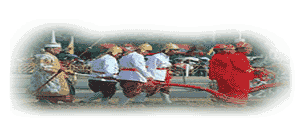
Translator : Aketawan Manowongsa
26 June 2002